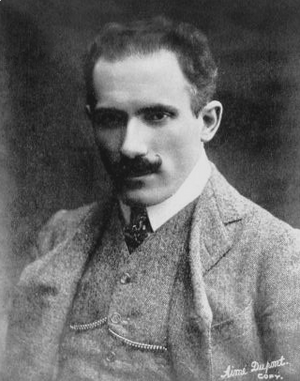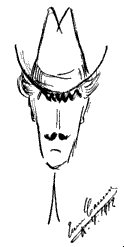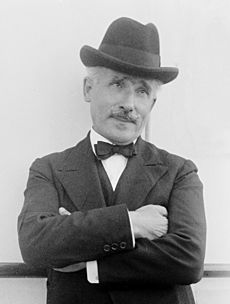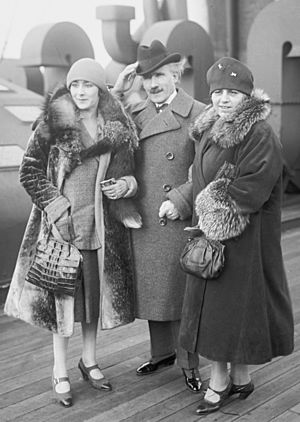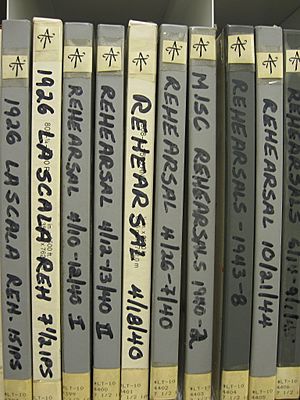Arturo Toscanini facts for kids
Arturo Toscanini (born March 25, 1867 – died January 16, 1957) was a famous Italian conductor. He was one of the most respected and important musicians of his time. People admired him for his strong passion, his desire for everything to be perfect, his amazing ear for how an orchestra should sound, and his incredible memory. He could remember entire musical scores! He led famous orchestras like La Scala in Milan and the New York Philharmonic. Later, he became the first music director of the NBC Symphony Orchestra. This made him very well-known, especially in the United States, thanks to his radio and television shows and many recordings.
Contents
- Biography: Toscanini's Life Story
- Personal Life: Family and Friends
- Innovations: Changing the Opera World
- First Performances: New Music Under His Baton
- Recorded Legacy: Hearing His Music Today
- Film: Toscanini on Screen
- Acclaim and Criticism: How He Was Seen
- Legacy: His Lasting Impact
- Quotations: Toscanini's Words
- See also
Biography: Toscanini's Life Story
Early Years: A Young Musician's Start
Toscanini was born in Parma, Italy. He won a scholarship to study the cello at a local music school. Life there was tough, and the food was mostly fish, which made him dislike seafood for the rest of his life!
In 1886, he joined an opera company's orchestra and toured South America. In Rio de Janeiro, during a show of the opera Aida, the conductor was having trouble. The singers refused to perform with him. In a moment of desperation, they asked Toscanini, who was only 19 and had no conducting experience, to take over. He knew the whole opera by heart! He led the two-and-a-half-hour show perfectly, all from memory. The audience was amazed by his youth and energy. This was the start of his amazing career as a conductor.
When he returned to Italy, Toscanini continued to conduct. He also played the cello in the first performance of Verdi's opera Otello. Verdi, a famous composer, was very impressed by Toscanini's talent and how well he understood music.
Rising to Fame: A World-Renowned Conductor
Toscanini's reputation as a skilled opera conductor grew quickly. He led the first performances of famous operas like Puccini's La bohème and Leoncavallo's Pagliacci. In 1896, he conducted his first concert with an orchestra. By 1898, he was the main conductor at La Scala, a very important opera house in Milan, where he stayed until 1908. He returned as Music Director from 1921 to 1929.
In 1908, Toscanini moved to New York to work at the Metropolitan Opera. He made many changes there that are still used today. After seven seasons, he almost sailed on the Lusitania, a ship that later sank, but he left a week earlier on another ship. From 1926 to 1936, he conducted the New York Philharmonic and toured Europe with them. He was the first non-German conductor to perform at the famous Bayreuth Festspielhaus in Germany. He also conducted at the Salzburg Festival and led the first concert of the Palestine Orchestra (now the Israel Philharmonic Orchestra).
Leaving Italy: Standing Up to Power
Toscanini was not a fan of the Fascist leader Benito Mussolini in Italy. He refused to display Mussolini's picture or play the Fascist anthem at La Scala. He was very brave in his defiance.
In 1931, at a concert in Bologna, Toscanini was ordered to play the Fascist anthem, but he strongly refused. Afterwards, he was attacked by a group of Mussolini's supporters. Mussolini was so angry that he had Toscanini's phone tapped and took away his passport. But after people around the world protested, his passport was returned. When World War II began, Toscanini left Italy. He returned in 1946 to conduct a concert for the reopening of La Scala, which had been damaged by bombs during the war.
The NBC Symphony Orchestra: Reaching Millions
In 1936, Toscanini was thinking about retiring. But David Sarnoff, the head of RCA, asked him to lead a new orchestra for radio concerts. Toscanini agreed and returned to the United States. He conducted his first broadcast concert with the NBC Symphony Orchestra on December 25, 1937, from NBC Studio 8-H in New York City. This studio was built for radio, so the sound was very clear but a bit dry. Later, the concerts moved to Carnegie Hall, a famous concert venue.
Toscanini was sometimes criticized for not playing enough American music. However, in 1938, he conducted the first performances of two pieces by Samuel Barber, Adagio for Strings and Essay for Orchestra, which were very successful. He also conducted works by Ferde Grofé (like Grand Canyon Suite) and George Gershwin (like An American in Paris). He even created his own version of The Star-Spangled Banner.
In 1942, Toscanini conducted the first American performance of Dmitri Shostakovich's Symphony No. 7. The music score was microfilmed in the Soviet Union and brought to the U.S. during World War II.
Toscanini's last broadcast performance was on April 4, 1954, at Carnegie Hall. He was 87 years old when he finally retired. After he left, the NBC Symphony Orchestra was disbanded.
Toscanini prepared and conducted seven complete operas for NBC radio, including La bohème, Aida, and Otello. These performances were later released on records, allowing people today to hear his amazing opera conducting.
Last Years: A Legacy Remembered
With the help of his son Walter, Toscanini spent his retirement reviewing his past performances. He enjoyed watching boxing, wrestling, and comedy shows on television.
Toscanini passed away on January 16, 1957, at the age of 89, in New York City. His body was returned to Italy and buried in Milan. His tombstone has a famous quote from when he conducted Puccini's unfinished opera Turandot: "Here the opera ends, because at this point the maestro died."
In 1987, he received the Grammy Lifetime Achievement Award after his death.
Personal Life: Family and Friends
Toscanini married Carla De Martini in 1897. They had four children: Walter, Wally, Giorgio (who died young), and Wanda.
His daughter Wanda married the famous pianist Vladimir Horowitz in 1933. Toscanini worked with Horowitz many times, and they recorded concertos together.
Toscanini remained married to Carla until she passed away in 1951. He never remarried.
Innovations: Changing the Opera World
At La Scala, Toscanini brought in many changes to how operas were performed. He insisted that the lights in the audience area be dimmed during performances. He believed that everything—the singers, orchestra, chorus, sets, and costumes—had to work together perfectly for a show to be truly artistic.
First Performances: New Music Under His Baton
Toscanini conducted the first performances of many operas, including Pagliacci, La bohème, La fanciulla del West, and Turandot. He also led the first Italian performances of several Wagner operas and the first American performance of Dmitri Shostakovich's Symphony No. 7. He also conducted the world premiere of Samuel Barber's Adagio for Strings.
Recorded Legacy: Hearing His Music Today
Toscanini made his first recordings in 1920 and his last in 1954. Most of his recordings were released by RCA Victor. He also made recordings with the New York Philharmonic and the BBC Symphony Orchestra.
He didn't like recording at first, especially the early methods. But as technology improved, he became more interested in preserving his performances. Most of his recordings were made with the NBC Symphony Orchestra, showing his conducting style in his later career.
What He Was Known For
Toscanini was especially famous for his performances of music by Beethoven, Brahms, Wagner, and Italian composers like Verdi and Puccini. Many of his recordings are still available today.
Rehearsals and Broadcasts
Many hours of Toscanini's rehearsals were recorded, and some of these have been released. There are also recordings of his concerts with other orchestras, like the New York Philharmonic and the BBC Symphony Orchestra.
From 1948 to 1952, Toscanini conducted ten concerts that were shown live on television by NBC. These included a full performance of Verdi's opera Aida and Beethoven's Ninth Symphony. These TV shows were saved on special films called kinescopes. They show how passionate and focused he was while conducting.
Film: Toscanini on Screen
In 1943, Toscanini made a short film for the U.S. government called Hymn of the Nations. In it, he conducted the NBC Symphony playing Verdi's Inno delle nazioni (Hymn of the Nations), which included national anthems. He added the Soviet "Internationale" and "The Star-Spangled Banner" to the piece. The film was nominated for an Academy Award!
There's also a movie about his early life called Young Toscanini (1988), which tells a fictional story about his first conducting experience in Rio de Janeiro.
Acclaim and Criticism: How He Was Seen
Throughout his life, Toscanini was greatly admired by critics, musicians, and the public. He was featured on the cover of Time magazine three times, which is very rare for a conductor. In 1989, the United States Postal Service even issued a postage stamp in his honor.
Some newer critics have suggested that Toscanini's focus on older European music, and the way he was marketed, might have limited the growth of American music. However, many composers and musicians who worked with him, like Aaron Copland, still praised his greatness.
Some critics also pointed out that many of his recordings from Studio 8-H didn't sound as good as they could have. This was because Studio 8-H was a radio studio, not a concert hall, and its acoustics weren't ideal for orchestral music.
Toscanini was also known for his strong temper during rehearsals. He would get very upset if the musicians weren't playing well.
Legacy: His Lasting Impact
After his death, NBC Radio broadcast a series called Toscanini: The Man Behind The Legend, which featured interviews and recordings of his performances.
In 1986, the New York Public Library for the Performing Arts bought most of Toscanini's papers, musical scores, and recordings. This huge collection, called The Toscanini Legacy, helps people study his life and work.
Quotations: Toscanini's Words
- About the composer Richard Strauss: "To Strauss the composer I take off my hat; to Strauss the man I put it back on again."
- "Gentlemen, be democrats in life but aristocrats in art."
- About the first movement of Beethoven's Eroica: "Some say this is Napoleon, some Hitler, some Mussolini. Bah! For me it is simply allegro con brio."
- At the point where Puccini stopped writing his unfinished opera, Turandot: "Here Death triumphed over art."
See also
 In Spanish: Arturo Toscanini para niños
In Spanish: Arturo Toscanini para niños



